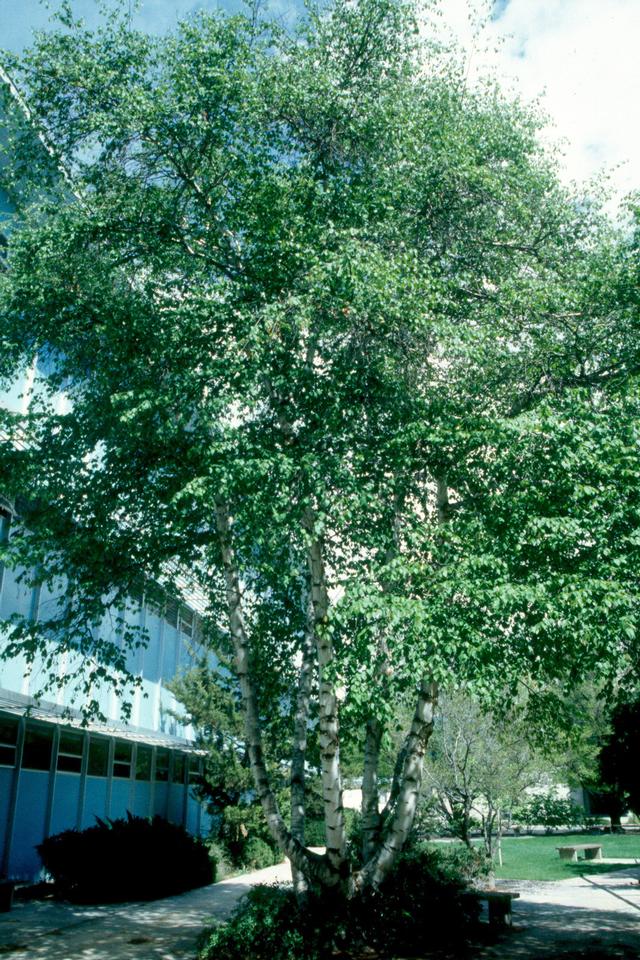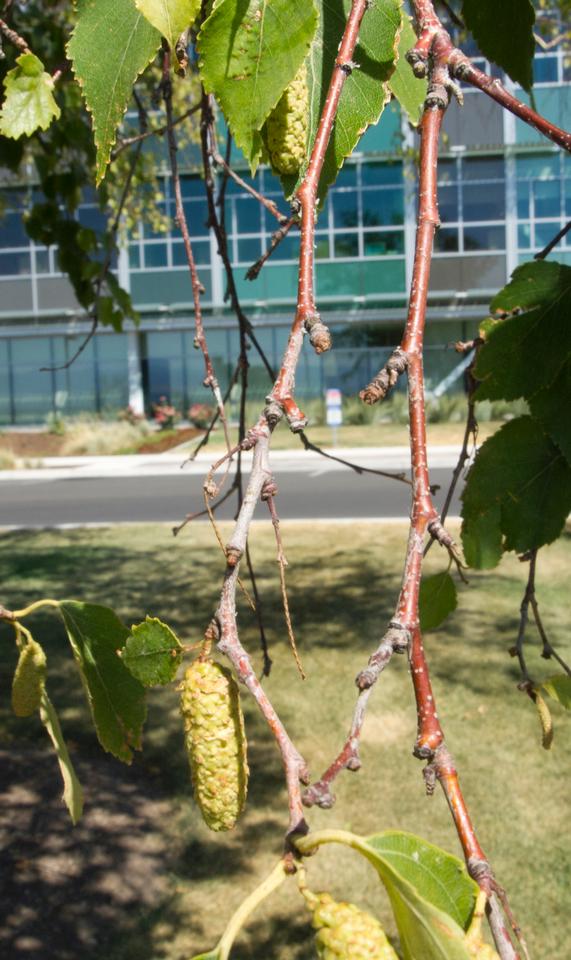Birch, Paper
Betula papyrifera
Betulaceae - Birch
Description
Leaves: Dark green above in summer and yellow in fall, hairless; paler green and hairy beneath; alternate; 3-1/2" long, egg-shaped to triangular, tapering to a point, oval or wedge-shaped; edges coarsely and doubly toothed; 1" petiole; 3 to 7 pairs of veins; deciduous.
Twigs/buds: Twigs dark red-brown to nearly black; slightly hairy when young, later mostly hairless; relatively thick; glandular when young. Buds brown to black, shiny; 1/4" to 1/2" long, egg-shaped; tapering and blunt-tipped; resinous; bud scales overlapping, scales greenish to brown, with downy edges.
Flowers/fruit: Flowers monoecious. Male flower tiny and held in a brown, 2" to 4" long catkin, arranged in 2's or 3's; female flower held in erect, green catkin, relatively short (over an inch long), arranged in 3's, stigmas pink to red. Fruit is a small (1/16"), winged nutlet carried on female catkin; stalk long; shed starting in late summer.
Bark: Iconic of northern North American forests; variable: typically bright creamy/chalky white and peeling with age, but sometimes remains dark or reddish and unpeeling (more common in the West); thin, peeling or easily separated into layers or large sheets; younger branches dark red to nearly black before becoming red-brown and then white; lenticels long and raised; inner bark red-orange, exposing a lot of inner bark can kill tree; used to make canoes.
Wood: Important; uniform in texture, pale, not odorous; lighter in weight, softer, and weaker than other birches; used to make toothpicks, ice cream sticks, tongue depressors, handles, spools, and toys.
General: A native of northern North America. The most widespread of North America's birches. A medium sized tree, up to 70' in height; larger than similar birches. Canopy is relatively narrow with ascending branches and a slender, sometimes curved trunk. May be borer prone, especially when stressed. Does well in cool, moist areas and full sun.
Landscape Use: Though rarely planted in Utah, it is commonly cultivated. Does well in places like parks and large areas. Specimens on the USU campus are doing well. Similar to European white birch (B. pendula) in appearance but with papery, peeling bark and without the weeping habit. Great bark and fall color; looks nice in winter in front of evergreens. Zones 2-7.
Cultivars: 'Belle Vue', 'Chickadee', 'Prairie Dream', 'Renaissance Oasis', 'Renaissance Reflection', 'Snowy', 'St. George'.
Characteristics
General
| Family | Betulaceae - Birch |
|---|---|
| Cultivar Availability | Yes |
| Hardiness Zone | 2-7 |
| Type | Broadleaf |
| Utah Native | No |
Growth
| Growth Rate | Medium |
|---|---|
| Mature Height | Medium |
| Longevity | Low |
| Is Good Under Power Lines | No |
| Crown Shapes | Pyramidal |
Ornamental
| Bark | Yes |
|---|---|
| Fall Color | Yes |
| Flowers | No |
| Foliage | No |
| Fruit | No |
Tolerance
| Shade | Medium |
|---|---|
| Salt | High |
| Drought | Low |
| Poor Drainage | Low |
| Alkalinity | Medium |
| Transplanting | Medium |







